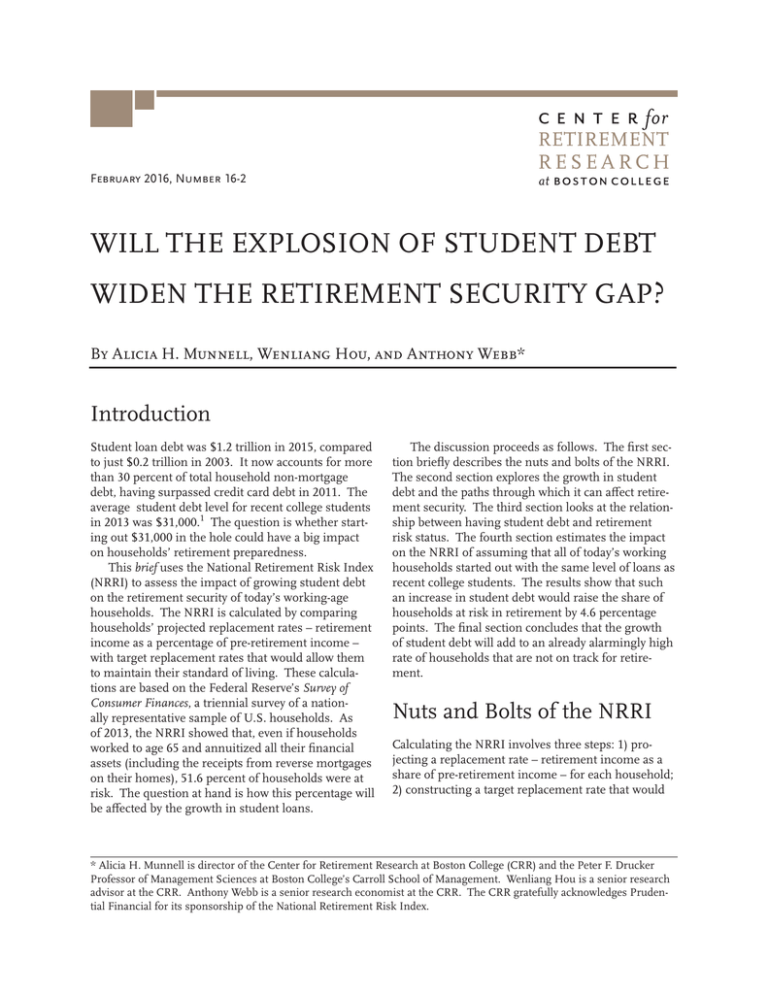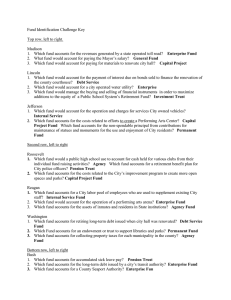
RETIREMENT
RESEARCH
February 2016, Number 16-2
WILL THE EXPLOSION OF STUDENT DEBT
WIDEN THE RETIREMENT SECURITY GAP?
By Alicia H. Munnell, Wenliang Hou, and Anthony Webb*
Introduction
Student loan debt was $1.2 trillion in 2015, compared
to just $0.2 trillion in 2003. It now accounts for more
than 30 percent of total household non-mortgage
debt, having surpassed credit card debt in 2011. The
average student debt level for recent college students
in 2013 was $31,000.1 The question is whether starting out $31,000 in the hole could have a big impact
on households’ retirement preparedness.
This brief uses the National Retirement Risk Index
(NRRI) to assess the impact of growing student debt
on the retirement security of today’s working-age
households. The NRRI is calculated by comparing
households’ projected replacement rates – retirement
income as a percentage of pre-retirement income –
with target replacement rates that would allow them
to maintain their standard of living. These calculations are based on the Federal Reserve’s Survey of
Consumer Finances, a triennial survey of a nationally representative sample of U.S. households. As
of 2013, the NRRI showed that, even if households
worked to age 65 and annuitized all their financial
assets (including the receipts from reverse mortgages
on their homes), 51.6 percent of households were at
risk. The question at hand is how this percentage will
be affected by the growth in student loans.
The discussion proceeds as follows. The first section briefly describes the nuts and bolts of the NRRI.
The second section explores the growth in student
debt and the paths through which it can affect retirement security. The third section looks at the relationship between having student debt and retirement
risk status. The fourth section estimates the impact
on the NRRI of assuming that all of today’s working
households started out with the same level of loans as
recent college students. The results show that such
an increase in student debt would raise the share of
households at risk in retirement by 4.6 percentage
points. The final section concludes that the growth
of student debt will add to an already alarmingly high
rate of households that are not on track for retirement.
Nuts and Bolts of the NRRI
Calculating the NRRI involves three steps: 1) projecting a replacement rate – retirement income as a
share of pre-retirement income – for each household;
2) constructing a target replacement rate that would
* Alicia H. Munnell is director of the Center for Retirement Research at Boston College (CRR) and the Peter F. Drucker
Professor of Management Sciences at Boston College’s Carroll School of Management. Wenliang Hou is a senior research
advisor at the CRR. Anthony Webb is a senior research economist at the CRR. The CRR gratefully acknowledges Prudential Financial for its sponsorship of the National Retirement Risk Index.
2
Center for Retirement Research
allow each household to maintain its pre-retirement
standard of living in retirement; and 3) comparing
the projected and target replacement rates to find the
percentage of households “at risk.”
Retirement income at age 65, which is defined
broadly to include all of the usual suspects plus housing, is derived by projecting assets that households
will hold at retirement, based on the stable relationship between wealth-to-income ratios and age evident
in the 1983-2013 Survey of Consumer Finances (SCFs).
As shown in Figure 1, wealth-to-income lines from
each survey rest virtually on top of one another, bracketed by 2007 values on the high side and 2013 values
on the low side.
Figure 1. Ratio of Wealth to Income by Age from
the Survey of Consumer Finances, 1983-2013
6
1983
1989
1992
1995
1998
2001
2004
2007
2010
2013
5
4
3
2
and imputed rent from housing. In essence, with
regard to wealth, income in retirement equals the annuitized value of all financial and housing assets; income before retirement is simply the return on those
same assets.2 Average lifetime income then serves as
the denominator for each household’s replacement
rate.
To determine the share of the population at risk
requires comparing projected replacement rates with
the appropriate target rates. Target replacement
rates are estimated for different types of households
assuming that households spread their income so as
to have the same level of consumption in retirement
as they had before they retired. Households whose
projected replacement rates fall more than 10 percent
below the target are deemed to be at risk of having
insufficient income to maintain their pre-retirement
standard of living. The NRRI is simply the percentage of all households that fall more than 10 percent
short of their target.
The NRRI has increased over time due to longer
life expectancies, reduced Social Security replacement
rates, and very low interest rates (see Figure 2). In
2013, the NRRI shows that 51.6 percent of today’s
working-age households were at risk of being unable
to maintain their pre-retirement levels of consumption once they stopped working. The question is how
the growth of student loans affects this percentage.
1
0
20-22
26-28
32-34
38-40
44-46
50-52
56-58
62-64
Source: Authors’ calculations based on U.S. Board of Governors of the Federal Reserve System, Survey of Consumer
Finances (SCF) (1983-2013).
Figure 2. The National Retirement Risk Index,
1983-2013
60%
53% 52%
37% 38%
40%
Sources of retirement income that are not derived
from SCF-reported wealth are estimated directly. For
defined benefit pension income, the projections are
based on the amounts reported by survey respondents. For Social Security, benefits are calculated
directly based on estimated earnings histories for
each member of the household.
A calculation of projected replacement rates also
requires income prior to retirement. The items that
comprise pre-retirement income include earnings,
the return on 401(k) plans and other financial assets,
40%
45% 44%
38%
31% 31% 30%
20%
0%
1983 1986 1989 1992 1995 1998 2001 2004 2007 2010 2013
Source: Munnell, Hou, and Webb (2014).
3
Issue in Brief
The Growth of Student Debt
Higher education is an important investment that
helps young workers obtain better jobs and higher
incomes. College graduates have lower unemployment rates, fare better during recessions, and enjoy
wages roughly double those of high school graduates.
But rising tuitions have made a college education very
expensive, and 55 percent of households ages 21-29
in 2013 had student debt, with an average amount of
$31,000.3
Total student debt now amounts to $1.2 trillion,
exceeding all other forms of non-mortgage debt,
including auto loans, credit cards, and home equity
loans (see Figure 3).4 The reasons for the growth are
not only that tuitions have increased but also that
more people are attending college and going on to
graduate school; parents are taking out college loans
for their children; and repayments are lower as borrowers delay through deferments and forbearances.
Figure 3. Non-Mortgage Debt Balances, Trillions
of Dollars, 2003-2015
$1.2
$0.9
Figure 4. Percentage of Student Loan Borrowers
90+ Days Delinquent, 2004, 2008, and 2012
30%
20%
20%
17%
16%
16%
14%
12%
11%
10%
2004
2008
2012
10%
8%
13%
9%
8%
0%
Age < 30
Ages 30-49
Ages 50+
All
Source: Consumer Credit Panel/Equifax (2015).
of income in retirement.5 Indeed, while student
debt is only one contributing factor, the SCF shows
that homeownership among households ages 30-39
declined from 58 percent to 53 percent between 2001
and 2013.
The SCF provides detailed data on student loan
debt by age and income level. The data by age show
that student debt is not just an issue for younger people, but also for their parents. The same increasing
trend appears for all age groups (see Figure 5). The
$0.6
Student loan
Auto loan
Credit card
Home equity
$0.3
$0.0
2003
2005
2007
2009
Year
2011
2013
2015
Figure 5. Percentage of Households with
Student Debt, by Age of Household Head
60%
55%
Ages 21-29
Ages 31-39
Ages 41-49
Ages 51-59
40%
Source: Federal Reserve Bank of New York, Consumer Credit
Panel/Equifax (2015).
20%
In 2012, 17 percent of borrowers were 90+ days
delinquent (see Figure 4). With student debt and
particularly delinquent student debt, it can be harder
to get a mortgage. Thus, in addition to getting a late
start on saving in a 401(k) plan, those with student
debt may also delay buying a house, a potential source
0%
17%
1992
1995
1998
2001
2004
Year
Source: 2013 SCF.
2007
2010
2013
4
Center for Retirement Research
data by income show that middle- and high-income
households are more likely to have student debt than
those in the bottom third of the income distribution,
since those with higher incomes are more likely to
have attended college (see Table 1).
Table 1. Percentage of Households with Student
Debt by Income Group, 2013
Income group
Student
debt
Low
Yes
14.6 %
25.6%
No
85.4
74.4
Middle
Total
Figure 7. NRRI for Households with Student
Debt, by College Completion, 2013
26.0 %
22.1 %
80%
74.0
77.9
High
Source: Authors’ calculations from the 2013 SCF.
Student Debt and the NRRI
Before estimating the impact of student debt on the
NRRI, it is useful to look at the relationship between
having student debt and retirement risk status.
Figure 6 shows that 60.1 percent of households with
student debt are at risk compared to 49.2 percent of
those without debt. These numbers suggest that – if
the two groups of households were identical – eliminating student debt could reduce the NRRI to 49.2
percent from the reported 51.6 percent.
Figure 6. NRRI for Households with and without
Student Debt, 2013
80%
60%
60.1%
49.2%
40%
20%
0%
With student debt
Source: Authors’ calculations.
The biggest difference in risk status occurs within
the group that has student debt (see Figure 7). Those
with student loans who have completed college have
only a slightly higher percentage at risk than those
without student debt (52.9 percent versus 49.2 percent), but for households with student loans that did
not complete college the difference is enormous (67.1
percent versus 49.2 percent).
Without student debt
67.1%
60%
52.9%
40%
20%
0%
Did not complete college
Completed college
Source: Authors’ calculations.
Student Debt Going Forward
The following exercise estimates the impact on the
retirement security of today’s working households
if they had started out with the same student debt
profile as recent college students. As discussed
above, student debt can directly reduce saving that
would have occurred through a retirement plan and
indirectly reduce retirement saving through mortgage
repayment.6
The first step involves giving the households in
the NRRI the same student loans when they were in
their twenties as recent college students. The 2013
SCF data for those ages 21-29 are used as an approximation for recent college students. Among this age
group, 55 percent of households had student debt,
with an average amount of $31,000.7 Thus, for NRRI
households, say ages 30-39, the percentage with student debt in their twenties was increased from their
actual 29 percent to 55 percent. These additional
5
Issue in Brief
households were assigned student debt of $31,000;
and those who already had student debt in their twenties had their loan amount increased from their actual
$18,000 to $31,000 (in 2013 dollars). Paying off these
extra loans is assumed to reduce a household’s retirement saving dollar for dollar. The foregone savings
grow at a real rate of 4 percent to age 65, at which
point they reduce assets, annuity income, and thereby
replacement rates. The same procedure is applied to
households ages 40-49 and 50-59.8
The second step involves assigning, to the NRRI
sample, lower homeownership levels and lower house
values and thereby less home equity at retirement.
The adjustment for the house comes from two equations that use data from the 2013 Survey of Consumer
Finances that relate the probability of owning a home
and the value of the home to the household having
student loan debt.
Table 2. Current NRRI and Projected NRRI with
Higher Student Debt, by Age Group
Eq.1: Probability owning a home = ƒ(age, having student loan, education, marriage, log income)
Table 3. Current NRRI and Projected NRRI with
Higher Student Debt, by Income Group
Eq.2: Log house value = ƒ(age, having student loan,
education, marriage, log income)
NRRI
The results of these equations show that households with student debt are 6.7 percent less likely to
own a home and that the homes they do own will
have a 5.4-percent lower value. To incorporate the
effect of student debt, homeownership and home values are decreased by these percentages for the NRRI
sample. As with the direct reduction in retirement
saving due to student debt, the reduction in home
equity reduces the amount that is annuitized at age
65, and this amount is subtracted from the household’s retirement income – the numerator of the
replacement rate. The new replacement rate for each
household is then compared to its target to determine
whether the household is at risk.
The results of increasing student debt for NRRI
households are shown in Table 2 (by age) and Table 3
(by income). The higher debt raises the NRRI from
its baseline level of 51.6 percent to 56.2 percent – 4.6
percentage points. This number probably should be
interpreted as an upper bound of the impact.9
Is 4.6 percentage points a big increase? One way
to put the number into context is to compare it to a
very dramatic policy change – a 19.6-percent acrossthe-board benefit cut in Social Security (exempting
current retirees) to eliminate the program’s longterm financing shortfall. Such a cut would raise the
NRRI by 10.7 percentage points. So, extrapolating the
effects of the growth in student debt into the future
has an impact that is roughly half as large as a huge
and unprecedented cut in the nation’s main source of
retirement income. The bottom line is that student
loans definitely have a meaningful adverse effect on
retirement security.
NRRI
Age group
30-39
40-49
50-59
Total
Current
58.9 %
51.7 %
45.3 %
51.6 %
Projected
62.0
55.8
51.6
56.2
Source: Authors’ calculations.
Income group
Low
Middle
High
Total
Current
59.5 %
52.2 %
43.4 %
51.6 %
Projected
65.8
56.9
46.2
56.2
Source: Authors’ calculations.
Conclusion
Student loan debt has been growing at a rapid clip
over the past decade, prompting widespread concerns
about its impact on the financial futures of young
Americans. This brief has focused on whether the
potential impact of growing student debt on future retirement security is big. This impact occurs through
two channels: directly, by reducing saving in retirement plans; and indirectly, by reducing the rate of
home ownership and home values.
The key finding is that – if today’s working-age
households had the same level of student debt as
those recently leaving college – an additional 4.6
percent of households would be at risk of having
inadequate income in retirement. This change represents a substantial increase in the already alarming
rate of households at risk – from 51.6 percent to 56.2
percent. The bottom line is that college costs should
be included in broader policy discussions over how to
improve lifelong financial security.
6
Center for Retirement Research
Endnotes
1 The aggregate loan data come from the Federal
Reserve Bank of New York. The average loan amount
comes from the Survey of Consumer Finances produced
by the U.S. Board of Governors of the Federal Reserve
System.
2 For the measures of retirement income and preretirement income, both mortgage debt and nonmortgage debt are subtracted from the appropriate
income components.
3 These data include both those who graduated college and those who attended but did not graduate. A
recent study by the Institute for College Access & Success (2015) that was limited to new college graduates
found that about 70 percent had student loan debt.
4 For more details on trends in student debt and
other borrowing activity, see Brown and Caldwell
(2013).
5 Brown et al. (2013) present an analysis of how student debt may affect access to other forms of borrowing, including home mortgages.
6 Hiltonsmith (2013) analyzed the effects of student
debt – in dollar terms – on both savings and homeownership. His study assumes different earnings
profiles for households with and without student
debt. However, Fry (2014) points out that earnings
profiles for households with and without student debt
show little variation, but net wealth does. Therefore,
our approach directly affect household wealth, rather
than earnings.
7 The sample excludes 6 percent of households in
their twenties who reported that they had college
loans but that neither spouse had education beyond
high school.
dollar for dollar, but students could instead repay a
portion of the loan by reducing their consumption.
Second, with respect to homeownership, our equation
assumes that student debt affects homeownership
equally for all ages but, in fact, the difference is probably larger at younger ages as households defer home
purchase and smaller at age 65, when the analysis
reduces the homeownership rate.
References
Brown, Meta and Sydnee Caldwell. 2013. “Young
Student Loan Borrowers Retreat from Housing
and Auto Markets.” Liberty Street Economics blog
(April 17). New York, NY: Federal Reserve Bank of
New York.
Brown, Meta, Andrew Haughwout, Donghoon Lee,
Joelle Scally, and Wilbert van der Klaauw. 2013.
“Does Rising Student Debt Affect the Home
Purchases of Young Borrowers?” Presentation at
Upjohn Institute. New York, NY: Federal Reserve
Bank of New York.
Federal Reserve Bank of New York. 2015. Consumer
Credit Panel/Equifax. New York, NY.
Fry, Richard. 2014. “Young Adults, Student Debt and
Economic Well-Being.” Washington, DC: Pew
Research Center.
Hiltonsmith, Robert. 2013. “At What Cost? How
Student Debt Reduces Lifetime Wealth.” Debt-forDiploma Series Working Paper. New York, NY:
Demos.
Institute for College Access & Success. 2015. “Student
Loan Debt Averages $28,950 for Class of 2014.”
Oakland, CA.
8 No student loan data are available in the SCF before
1992. Therefore, for households ages 50-59, the analysis estimates the percentage who would have had
loans in their twenties and the average dollar amount
of the loans based on the 1992-2013 data.
Munnell, Alicia H., Wenliang Hou, and Anthony
Webb. 2014. “NRRI Update Shows Half Still Falling Short.” Issue in Brief 14-20. Chestnut Hill, MA:
Center for Retirement Research at Boston College.
9 The 4.6 percentage-point change is an upper bound
for two reasons. First, the analysis implicitly assumes that student debt displaces retirement saving
U.S. Board of Governors of the Federal Reserve
System. Survey of Consumer Finances, 1983-2013.
Washington, DC.
RETIREMENT
RESEARCH
About the Center
The mission of the Center for Retirement Research
at Boston College is to produce first-class research
and educational tools and forge a strong link between
the academic community and decision-makers in the
public and private sectors around an issue of critical importance to the nation’s future. To achieve
this mission, the Center sponsors a wide variety of
research projects, transmits new findings to a broad
audience, trains new scholars, and broadens access to
valuable data sources. Since its inception in 1998, the
Center has established a reputation as an authoritative source of information on all major aspects of the
retirement income debate.
Affiliated Institutions
The Brookings Institution
Massachusetts Institute of Technology
Syracuse University
Urban Institute
Contact Information
Center for Retirement Research
Boston College
Hovey House
140 Commonwealth Avenue
Chestnut Hill, MA 02467-3808
Phone: (617) 552-1762
Fax: (617) 552-0191
E-mail: crr@bc.edu
Website: http://crr.bc.edu
© 2016, by Trustees of Boston College, Center for Retirement Research. All rights reserved. Short sections of text, not to
exceed two paragraphs, may be quoted without explicit permission provided that the authors are identified and full credit,
including copyright notice, is given to Trustees of Boston College, Center for Retirement Research.
The research reported herein was supported by Prudential Financial. The findings and conclusions expressed are solely those
of the authors and do not represent the opinions or policy of Prudential Financial or the Center for Retirement Research at
Boston College.







